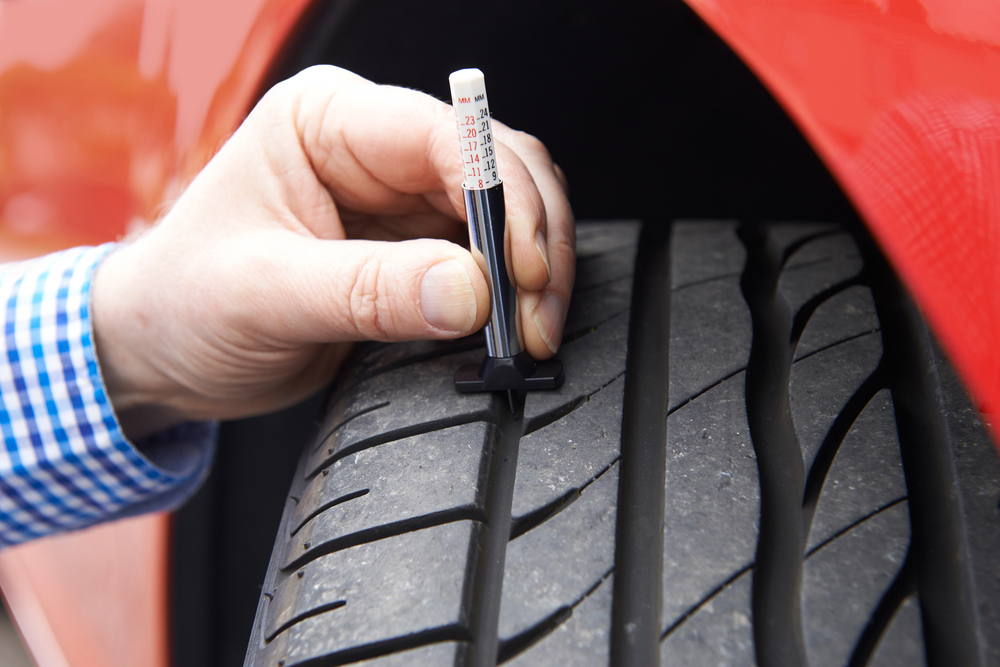Having a vehicle means understanding the various functions of certain moving parts, such as the tires and their tread. Tire tread depth is an essential part of the tire as well as the safety and performance of the vehicle. Yet, the tread is often overlooked by drivers. Maintaining adequate tread depth is essential for ensuring that your vehicle can handle various driving conditions effectively. Let’s learn more about the importance of tire tread depth and how a simple test can keep you out of terrible predicaments and accidents on the roadway.
Key Takeaways
- Adequate tire tread depth is crucial for traction, preventing hydroplaning, and ensuring effective braking.
- Use a tread depth gauge or the penny test to monitor tread depth. Replace tires if the tread is too shallow.
- Replace tires when tread depth reaches 4/32 of an inch, or as required by local regulations.
- Regularly consult a tire technician to evaluate tire condition and determine if replacement is needed.
Understanding Tire Tread Depth
Tire tread depth refers to the measurement of the tire’s tread pattern from the surface to the base of the grooves. This depth directly influences the tire’s ability to grip the road. Proper tread depth ensures that your tires can effectively channel water away from the contact patch, providing better traction and reducing the risk of hydroplaning.
How Tire Tread Keeps You Safe on the Road
Now that you know more about the patterns on your tires, let’s take a look at their functions and how the tread keeps your wheels on the road.
Traction and Handling
Adequate tread depth is vital for maintaining proper traction, especially in adverse weather conditions such as rain, snow, or ice. Worn-out tread can significantly reduce the grip your tires have on the road, leading to compromised handling and an increased risk of skidding or loss of control. Ensuring your tires have sufficient tread depth helps keep your vehicle stable and responsive in various driving conditions.
Hydroplaning Prevention
Tires with shallow tread depth are more prone to hydroplaning, a dangerous situation where the tire loses contact with the road surface due to a layer of water. This can result in sudden loss of control, especially during heavy rain. Maintaining the recommended tread depth helps to efficiently channel water away from the tire’s surface, reducing the risk of hydroplaning.
Braking Performance
The tread depth of your tires affects your vehicle’s braking distance. Shallow tread can lead to longer stopping distances, as the tires have less grip on the road surface. Adequate tread depth ensures that your vehicle can stop more quickly and safely, which is crucial for avoiding accidents and responding effectively to sudden stops.
Legal and Recommendation Tread Depth
Most jurisdictions have legal minimum tread depth requirements, often around 2/32 of an inch. However, many safety experts recommend replacing tires when tread depth reaches 4/32 of an inch, especially if you frequently drive in wet or slippery conditions. Regularly checking your tread depth and replacing tires before they reach the legal minimum can enhance your safety on the road.
How to Check Tread Depth
You can check your tire tread depth using a tread depth gauge or the “penny test.” To perform the penny test, insert a penny into the tread grooves with Lincoln’s head facing down. If you can see the top of Lincoln’s head, the tread is too shallow, and it’s time to replace the tires.
When to Replace Your Tires
It’s crucial to monitor your tire tread depth regularly and replace tires when necessary to maintain optimal safety and performance. While tread depth is a key indicator, several other factors also play a role in determining whether your tires need replacement. Here are some additonal things to look out for:
Uneven Wear
Tires can wear unevenly due to various issues such as misalignment, improper inflation, or suspension problems. Uneven wear can significantly impact your vehicle’s handling and safety. Inspect your tires regularly for signs of uneven wear patterns, such as more wear on one side of the tire or noticeable grooves and bulges. If you notice any irregularities, it’s important to have your tires inspected by a professional to address the underlying issues and determine if replacement is necessary.
Tire Damage
Physical damage to tires, such as cuts, punctures, or sidewall bulges, can compromise their integrity and safety. Even if the tread depth appears sufficient, significant damage can make the tire unsafe for use. Check your tires for visible signs of damage and have any issues addressed immediately. A professional tire technician can assess the extent of the damage and advise whether the tire needs to be replaced or can be repaired.
Performance Issues
If you experience a noticeable decline in vehicle performance, such as decreased traction, increased road noise, or a rough ride, it may be an indication that your tires are no longer performing effectively. These issues can result from worn tread, damage, or aging. Regularly monitoring your vehicle’s performance and addressing any concerns with a professional can help ensure that your tires are in good condition and replace them if necessary.
Contact Elmer’s Auto Body Today to Learn More
Maintaining proper tire tread depth is essential for safe driving. Adequate tread ensures optimal traction, prevents hydroplaning, and improves braking performance. Regularly checking and maintaining your tire tread depth not only enhances your safety but also contributes to better vehicle performance and longer tire life.
Safety is the name of the game for us here at Elmer’s Auto Body in South Jersey. Although we are a collision repair center, we aim to educate drivers in South Jersey to help stop collisions before they begin. Ensuring your tires have a decent amount of tread is one way to prevent accidents. If you do find yourself in a collision and need repairs, please contact one of our three South Jersey locations to schedule an appointment today.

